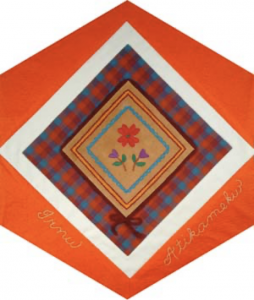Atikamekw

The Block
Mme Alice Awashish Petiquay is an Elder of the Atikamekw who continues to use traditional methods and materials to create clothing and crafts. Her block reflects the practice of using smoked moose hide decorated with floral motifs drawn from nature, but she has used colourful, modern cotton threads in the place of ones made from traditional sinews and nerves, or bark fibres. Previously, they would have used a whole range of vegetable- and mineral-based dyes to create such vibrant colours. This style of embroidery is often found on mittens, moccasin vamps, and on vests or other clothing. Atikamekw rarely use geometric forms or animal shapes and even contemporary artists make pieces that reflect the use of the appropriate forms, designs and colours of their culture. Plaid fabrics are commonly used to make baby-carriers, and are still used in skirts worn by elder women today.
Cultural Profile
The Atikamekw used to be called “Tête de Boule” by French explorers, a reference believed to result from the style of hat that was worn to protect the natives from flies. Their nomadic life was disrupted by the arrival of fur traders, the construction of trading posts, river dams and railways, as well as forest exploration within their territories in modern times. Their diet consisted mostly of game and fish; they are believed to be the originators of the “maple syrup” industry in Quebec, because they used to make sugar and syrup from sap boiled in the springtime.
Today, the Atikamekw put a lot of effort into educational programmes, health and social services, and economic development and tourism. As well, the Nation is concentrating on preserving and promoting traditional activities based on the “six seasons” of the Atikimekw that are based on respect for the environment. There are three communities in the Haute Mauricie and Lanaudière region of Quebec (Wemotaci, Opitciwan and Manawan). Each community has its own band council to handle the administration of local affairs, but is represented politically by the Conseil de la Nation Atikimekw, also known as Atimimeks-sipi. Their own language (Atikamekw), an Algonquin language closely related to Cree, is strong within their communities, while French is the most commonly used second language.
Sponsor: Anonymous
